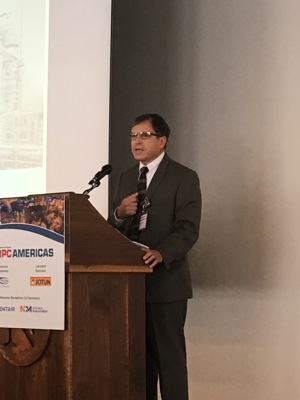IRPC Americas '17: FCC process history driven by war, competition
Adrienne Blume, Executive Editor
HOUSTON—Phillip Niccum, Senior Vice President, Process Engineering for KP Engineering, opened the second day of Gulf Publishing Company's International Refining and Petrochemical Conference (IRPC) Americas 2017 with a keynote talk on the history and development of the fluid catalytic cracking (FCC) process.
Early FCC foundations. The first catalytic cracking of heavy oil was commercialized in 1915 by A. M. McAfee of Gulf Refining at Gulf's Port Arthur refinery. However, the process was deemed uneconomical due to its high costs. The M. W. Kellogg Co. later advanced the process with its thermal cracking stills, along with other companies. In the 1920s, thermal crackers and thermal reforming improved gasoline pool octane.
In 1921, Fritz Winkler of BASF invented the fluid bed for contacting coarse lignite particles and gas. Later in the decade, M. W. Kellogg opened laboratories to study new processes for major oil companies. They developed the deasphalting, wax filtration, phenol extraction, catalytic polymerization, moving bed catalytic cracking, catalytic reforming and alkylation processes, among others.
Under UOP, the Dubbs Cracking Process was commercialized in 1923 at Shell's Wood River, Illinois refinery. From there, Eugene Houdry developed a fixed-bed catalytic process in the late 1920s. It was commercialized in 1937 at Sun Oil's Marcus Hook refinery, producing twice the gasoline yield of thermal crackers.
However, Houdry demanded $50 MM in royalties from Standard Oil of New Jersey for the catalytic cracking process, which led to the formation of a Catalytic Research Associates (CRA) in 1938 by a number of companies to engineer a similar process and thereby avoid Houdry's royalty demands.
FCC commercialization. The first FCC unit was built by M. W. Kellogg in Baton Rouge, Louisiana and was started up by operator Standard Oil in May 1942. The synthetic alumina catalyst was supplied by Davison Chemical. Another key breakthrough in the early days of FCC was the discovery that the dilute phase interface would form in the pilot plant if the vessels were tall enough.
During World War 2, the high-octane fuel produced from Houdry's FCC process played a significant role in the victory of the Allied forces. Total World War 2 cracking capacity from the Houdry process and others was tallied at 940 Mbpd. After the war, strong economics and fierce competition among FCC licensors drove developments during peacetime.
UOP introduced a stacked FCC unit that was small and economical, while Esso continued to develop new models through the 1950s. Its Model 4 featured a lower profile, no expansion joints and indirect control of catalyst circulation. Esso introduced the fluid coking process in the 1950s, which utilized residue thermal cracking.
The hydroforming process was also introduced in the 1950s by Standard Oil, Standard of Indiana and M. W. Kellogg. The fluid hydroforming process was commercialized in Destrehan, Louisiana. In 1955, Standard of Indiana started up a 40-Mbpd fluid hydroformer at Whiting, Indiana. However, the unit exploded on August 27, 1955 and was not rebuilt.
The Fischer-Tropsch synthesis process was commercialized in South Africa. Also in South Africa, the world's first fluid catalytic olefins unit was commercialized by Sasol in Secunda in 2006, to make ethylene, propylene, benzene, toluene and xylene. In 2013, KiOR converted wood to biofuel in an FCC unit in Mississippi.
The FCC process, driven by wartime necessity and fueled by trial, has undergone many innovative developments and changes throughout the 100-plus years since the foundations of its development. It remains the cornerstone of refinery fuel production today, Mr. Niccum said.
IRPC Americas 2017 is taking place at Norris Conference Center–CityCenter in Houston, Texas, from 18–19 July.







Comments